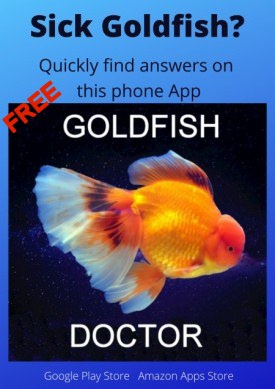| Back to Back Issues Page |
 |
|
The Goldfish Gazette, Issue #091 Mixed Varieties Feeding July 30, 2021 |
Goldfish Care TipsA Free Monthly Resource For Goldfish Enthusiasts In This Issue There are over 100 known varieties of Goldfish, and each are unique when it comes to their needs at feeding time. Mixed Varieties Feeding
Aquarium Pecking OrderThe pecking order in a mixed variety aquarium would be thus:Single tailed varieties first to the food Twin tailed varieties with normal eyesight next Twin tailed varieties with telescopic eyes next Last to the food, twin tailed varieties with physical hindrances (think Water Bubble Eyes) Size would have an influence on this pecking order. A large fantail (Ryukin) would probably be able to compete with smaller single tailed fish, while they remained small. Other physical characteristics can play a part during feeding. As Goldfish age, fins get longer, and wen growth can start to cover eyes. Feeding Competition SensitivityThe pecking order above is an over-simplification, as many other factors can influence how much food a Goldfish gets, but I have been surprised by how much effect small physical differences make.An example of how sensitive to feeding varieties are, I put my pair of Celestials in with a few Black Moor in an outside pond. Both are twin tailed with poor eyesight, so I reasoned that as the Celestials were slightly bigger than the Black Moor, feeding shouldn’t be a problem. Generally, I have always kept Celestials and Water Bubble Eyes on their own. I was wrong. After a few weeks I noticed the Celestials were not as plump as I would have liked, and all the Moors were looking very well fed. The Black Moor, although being short-sighted, still had an advantage over the Celestials that can only discover food beneath them by smell. Excessive Competition SymptomsThe most common sign of a fish not competing well for food is lack of growth compared to its tank mates.Over time, the fish seems to get smaller and smaller, but actually it is its tank mates getting larger. It gets worse. The small under-fed fish is now susceptible to diseases. A common myth is Black Moor aren’t a strong variety as they are the ones that get sick first in an aquarium community. The truth is Black Moor are one of the more popular varieties added to create interest in an aquarium full of normal eyed, single tailed Goldfish. Another common symptom with fancy varieties is swim bladder disorder or, more accurately, indigestion. A starving fish will often start gulping air when attempting to get what little food is left. The fish that do this are usually painfully thin, and the next stage is death, either by complications from floating upside down, or disease. Feeding OptionsHere are some easy techniques you can use that will help reduce excessive feeding competition in a mixed varieties aquarium.• Keep fish numbers in the aquarium low. If you observe some of your fancy Goldfish missing out in the food race, you can divide the aquarium during feeding with a piece of acrylic. To be practicable, fish numbers would need to be small. • Feed enough food. If you are only feeding the bare minimum required to sustain your fish, competition at feeding time increases. • Use a veggie clip to hang green food in the aquarium. Provide enough so that it will take a few hours for it to be eaten, giving all the fish time to get their share. • Plugs of Gel food can be stuck to surfaces in different areas of the aquarium.
New Mobile Phone AppMany posts on social media Goldfish groups, and emails I receive are about sick Goldfish.In response to this I have created a mobile phone app that allows the user to quickly narrow down possible causes and find the best treatments. The App is presently available on Google Play (US$0.99), and on Amazon Appstore for free. (Android phones only presently sorry). You don't have to download the App to get a preview of how the App works. I would like your opinion on whether you think the App is both useful and user friendly for less experienced Goldfish keepers than yourselves. Comments? Ideas? Feedback? I'd love to hear from you. Just reply to this e-zine and tell me what you think, or what topics you want covered. Next Month's Topic Pond Water Healthwww.facebook.com/aboutgoldfish |
| Back to Back Issues Page |

